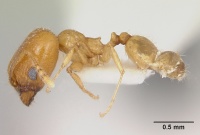Pheidole aurea
| Pheidole aurea | |
|---|---|

| |
| Scientific classification | |
| Kingdom: | Animalia |
| Phylum: | Arthropoda |
| Class: | Insecta |
| Order: | Hymenoptera |
| Family: | Formicidae |
| Subfamily: | Myrmicinae |
| Tribe: | Attini |
| Genus: | Pheidole |
| Species: | P. aurea |
| Binomial name | |
| Pheidole aurea Wilson, 2003 | |
Nothing is known about the biology of aurea.
Identification
See the description in the nomenclature section.
Keys including this Species
Distribution
Only known from the type locality.
Latitudinal Distribution Pattern
Latitudinal Range: 30.9° to 20.2302194°.
| North Temperate |
North Subtropical |
Tropical | South Subtropical |
South Temperate |
- Source: AntMaps
Distribution based on Regional Taxon Lists
Nearctic Region: United States (type locality).
Distribution based on AntMaps
Distribution based on AntWeb specimens
Check data from AntWeb
Countries Occupied
| Number of countries occupied by this species based on AntWiki Regional Taxon Lists. In general, fewer countries occupied indicates a narrower range, while more countries indicates a more widespread species. |

|
Estimated Abundance
| Relative abundance based on number of AntMaps records per species (this species within the purple bar). Fewer records (to the left) indicates a less abundant/encountered species while more records (to the right) indicates more abundant/encountered species. |

|
Biology
Castes
Nomenclature
The following information is derived from Barry Bolton's Online Catalogue of the Ants of the World.
- aurea. Pheidole aurea Wilson, 2003: 557, figs. (s.w.) U.S.A.
Unless otherwise noted the text for the remainder of this section is reported from the publication that includes the original description.
Description
DIAGNOSIS A member of the “bicarinata subgroup” of the larger pilifera group, which subgroup comprises Pheidole agricola, Pheidole aurea, Pheidole bajaensis, Pheidole barbata, Pheidole bicarinata, Pheidole centeotl, Pheidole cerebrosior, Pheidole defecta, Pheidole gilvescens, Pheidole macclendoni, Pheidole macrops, Pheidole marcidula, Pheidole paiute, Pheidole pinealis, Pheidole psammophila, Pheidole xerophila, Pheidole yaqui and Pheidole yucatana; and is characterized by the large to very large forward-set eyes of both castes; and in the major, the occipital lobes lacking any sculpturing (except in aurea); the posterior half of the head capsule almost entirely smooth and shiny; and the postpetiolar node seen from above oval, elliptical, or laterally angulate (rarely cornulate, never spinose). P. aurea in particular is distinguished by the following combination of traits.
Major: yellow; occiput with narrow band of transverse rugulae, which do not extend all the way across the occipital lobes; propodeal spines blunt, equilaterally triangular; humerus subangulate in dorsal-oblique view; postpetiolar node elliptical when seen from above.
Minor: clavate hairs present on promesonotal dorsum.
MEASUREMENTS (mm) Holotype major: HW 0.84, HL 0.92, SL 0.50, EL 0.20, PW 0.40. Paratype minor: HW 0.42, HL 0.48, SL 0.46, EL 0.12, PW 0.26.
COLOR Major: medium yellow, head slightly darker in shade than rest of body.
Minor: concolorous medium yellow.
Figure. Upper: holotype, major. Lower: paratype, minor. Scale bars = 1 mm.
Type Material
TEXAS: 5 km northwest of Eldorado, Schleicher Co., col. O. F. Francke. Museum of Comparative Zoology
Etymology
L aurea, gold, referring to the yellow color of both worker castes, and the type locality (El Dorado).
References
- Wilson, E. O. 2003. Pheidole in the New World: A dominant, hyperdiverse ant genus. Harvard University Press, Cambridge, MA. (page 557, fig. major, minor described)
References based on Global Ant Biodiversity Informatics
- Dattilo W. et al. 2019. MEXICO ANTS: incidence and abundance along the Nearctic-Neotropical interface. Ecology https://doi.org/10.1002/ecy.2944
- Wilson, E.O. 2003. Pheidole in the New World: A Dominant, Hyperdiverse Genus. Harvard University Press



